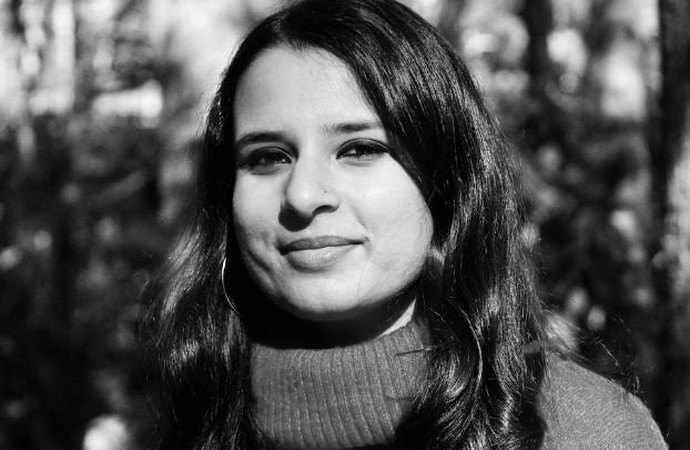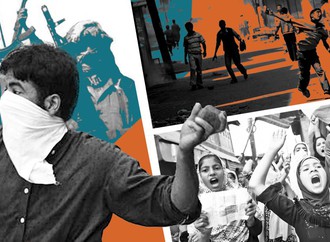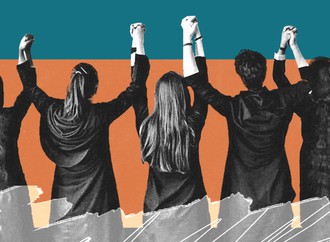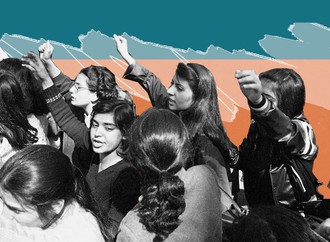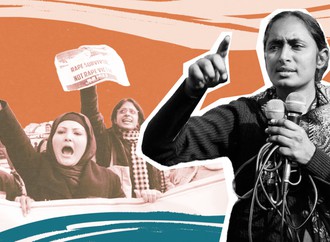This interview with Kashmir historian Hafsa Kanjwal delves into the complexities of India’s settler-colonial politics in Kashmir. Apart from detailing the evolution of the Kashmir Issue, this interview illuminates the similarities and differences between India’s and Russia’s long projects of occupation of Kashmir and Ukraine, respectively. This comparison reveals that even culturally, politically, and ideologically disparate entities, like Kashmir and Ukraine, may have remarkably similar histories of resisting imperial powers that have utilized both direct violence, including military invasions, torture, and mass killings, and structural oppression, such as censorship, propaganda, and manipulative politics to subjugate native populations.
This interview is presented in two parts. The first one focuses on the general history of the Kashmir Issue – the Kashmiri people’s struggle for self-determination against the Indian State. To this end, this first segment examines key historical moments in Kashmir’s modern history, various political responses to India’s forced rule over the region, and the impact of the struggle against India’s occupation on Kashmiri identity, culture, and life.
The second part of the interview center on three distinct periods of upheaval and political change in Kashmir from the 1950s to the present time. It will underscore the concrete organizational struggle for self-determination of the Kashmiri people against the Indian State, the role of censorship, Kashmiri cultural resistance, and broader geo-political connections, particularly regarding the Ukrainian and Palestinian questions.
Hafsa Kanjwal is an Assistant Professor of South Asian History at Lafayette College (Easton, Pennsylvania) and the author of Colonizing Kashmir: State-Building Under Indian Occupation (Stanford University Press, 2023). Her work offers readers a historiographical account and thorough analysis of India’s settler-colonial and state-building practices during the 1950s-1960s in Kashmir. The interview is conducted by Salik Basharat Geelani, a Kashmiri doctoral student in the Dep. of English Literature at Vanderbilt University, USA; and Yuliia Kulish, a doctoral student in the Dep. of Literature, Kyiv-Mohyla Academy.
Very few people in Ukraine are aware of the political situation in Kashmir and the extent of their understanding can be summed up in the phrase, "it's not very safe there." Before delving into the reasons for this lack of knowledge, could you give us a brief historical overview of modern Kashmir from your perspective as a native Kashmiri woman and historian? What key factors or events should our readers know to grasp the complex dynamics of Kashmiri politics?
I would begin the story of modern Kashmir in 1846 with the Treaty of Amritsar. This year, the land and the people of Kashmir were sold by the British Colonial Government to the Dogras, who were a Hindu warlord family from the Jammu region. The Treaty of Amritsar was drafted in return for the assistance of the Dogras in the First Anglo-Sikh War by which the British tried to take over the neighboring region of Punjab and overthrow the Sikh Empire. During this time, Kashmir was a province within the broader Sikh Empire. With the sale of Kashmir by the British and the subsequent Dogra expansion into neighboring territories, what's called the Princely State of Jammu and Kashmir came together.

British troops crossing the Sutlej (Punjab, an Indian state on the border with Pakistan) in boats, February 10, 1846. Illustration from the book by Sir Henry Youle
To better explain these administrative terms, let me give you a brief overview of British colonial rule in the subcontinent. Certain parts of the Subcontinent (think modern day India, Pakistan, and Bangladesh) that were directly under British Rule were called British India. And then there were these Princely States, over 565 of them, that were ruled by regional monarchs. Jammu and Kashmir was a Princely State and within it the majority of the population was Muslim, although there were, of course, Buddhist, Sikh and Hindu minority communities in the region too.
What was unique about this Princely State was that the rulers of Kashmir, the Dogra Maharajas Gulab Singh, Ranbir Singh, Pratap Singh, and Hari Singh, were Hindus. So, you had a situation where the ruler was Hindu and the majority of the population was Muslim. As historians like Mridu Rai have documented, the Dogras ran what we would today consider to be a Hindu State which specifically marginalized Kashmir's Muslim population. This was largely done through an extractive political economy. Kashmiri Muslims at this point were largely peasants, laborers, and artisans. They were highly taxed. They were illiterate. They were forced to partake in something called begar or enforced labor. And any privileges or benefits offered by the State were given almost exclusively to Kashmir’s Hindu communities in Jammu and in the Kashmir Valley.
Against this oppressive regime, Kashmiri Muslims began to mobilize as early as the 1920s, if not before. What's interesting is that in India the broader context of what was happening at this time was the anti-colonial agitation against the British, but in Kashmir the agitation was against Kashmir's princely rulers—against the Dogra monarchy. Kashmiri Muslims begin to mobilize, to create organizations that initially seek better representation, employment, and education for Muslims. But then with time they start to envision a post-Dogra future.
In 1947, the partition of the subcontinent happened. Independence was granted to the two new Nation States of India and Pakistan. As a Princely State, Kashmir was supposed to decide which country it would join, and geography as well as the demographics of the region were important factors to consider. But, starting in the spring of 1947, there was a rebellion in the region of Poonch within the Jammu and Kashmir Princely State. The Maharaja quashed the rebellion and committed a massacre, in particular of Muslims, in Jammu. The Jammu Massacre of 1947 is erased in Indian nationalist histories of the region and time period. What's focused on instead is the fact that because of this massacre and the indiscriminate killing of Muslims in the region of Jammu, Pathan Muslims from Northwest Pakistan, come to Kashmir in order to, from their perspective, liberate the region from the despotic Dogra rule. As a result of the Pathan movement into Kashmir, the Maharaja panics and turns to the Government of India, which promises military aid as long as the Maharaja immediately signs an Instrument of Accession.
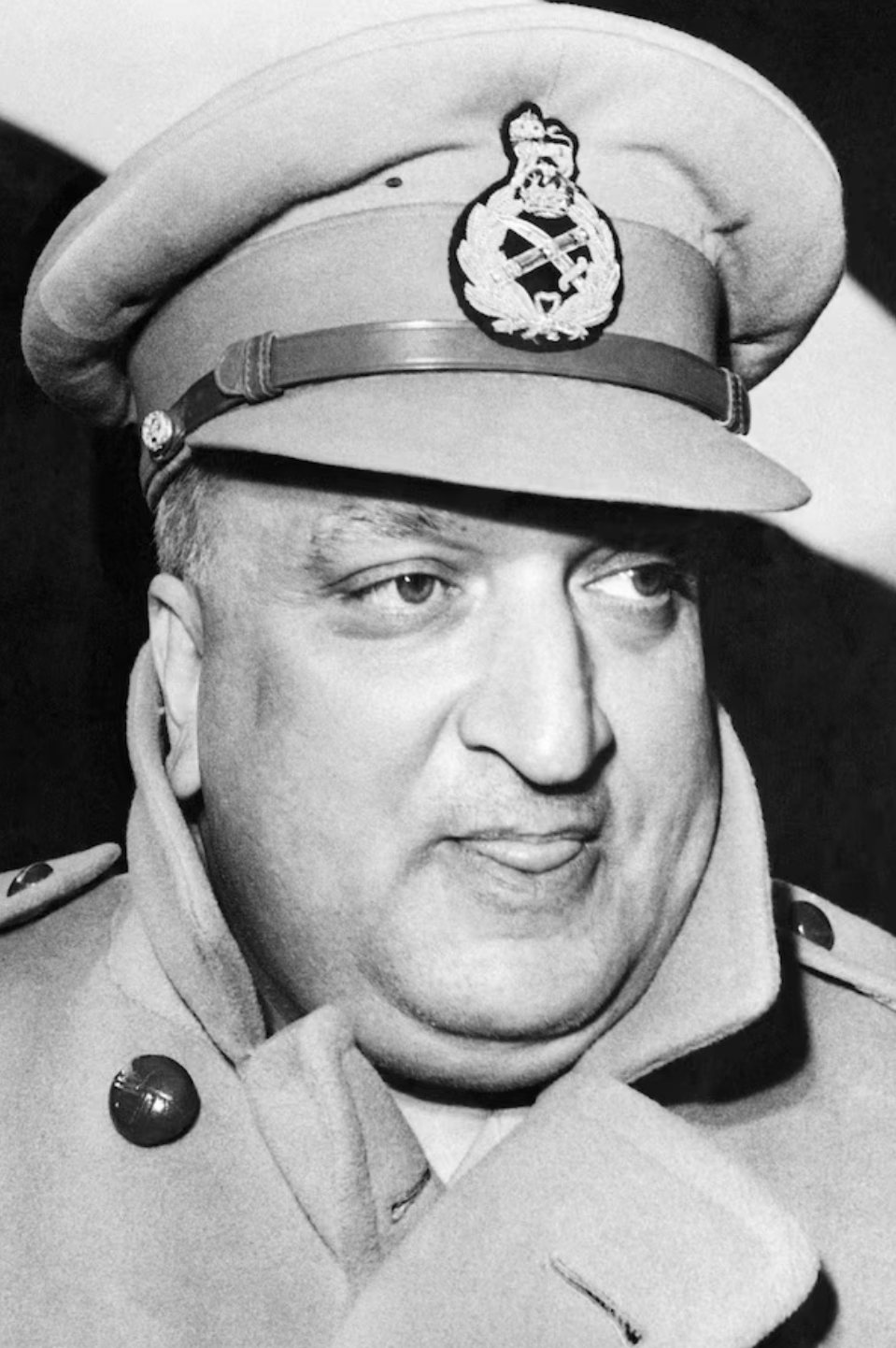
The last Maharaja of Kashmir, Hari Singh, in June 1946. Photo: AР
The Instrument of Accession is a contested document. When the Maharaja signed it, whether he truly signed it, and under what conditions he signed the document are questioned. But nonetheless, the Instrument of Accession (supposedly signed on the 26th of October 1947) is the main legal claim that India has in terms of its hold or rather its takeover of Kashmir. What's important to know is that in the acceptance of the document by then governor-general Lord Mountbatten, it is stated that the future of the region would be decided according to the reference of the people.
After the accession instrument was signed, the Indian army moved into Kashmir (some have argued that certain regiments were already there beforehand). This is what many Kashmiris, in particular Kashmiri Muslims, describe as the beginnings of the Indian occupation of Kashmir. As soon as the Indian Army moves into Kashmir, Pakistan's formal army gets involved and a war breaks out between India and Pakistan (the first of four) which results in United Nations Security Council Resolution 47, adopted on April 21, 1948. India had actually taken the Kashmir issue to the UN thinking that the UN would side with India, but the UN instead calls for a plebiscite to be held in the region once there's a cessation of hostilities. This call for plebiscite is what has shaped the contours of the issue for much of the second-half of the 20th century. It has also in many ways shaped the kinds of political imaginaries that Kashmiris have been able to imagine.
After the partition of the subcontinent, the region of Kashmir is split between the two new nation states of India and Pakistan, and China. India takes a little over 50% of the region, Pakistan takes about 30%, and China takes the rest. So in terms of the map, Azad Kashmir and Gilgit Baltistan are controlled by Pakistan and Jammu & Kashmir and Ladakh are under Indian control. China controls the Aksai Chin region.
Within Indian Occupied Kashmir, the Indian State places a series of client regimes in power. One of the main reasons why these client regimes initially agree to the accession is that India promises to grant Kashmir some level of self-autonomy and enshrines this promise in something called Article 370 of the Indian Constitution. But that autonomy is not actually granted. India used these client regimes and the “promise of autonomy” in the 1950s and 1960s to entrench its occupation in Kashmir and ensure that a plebiscite or any kind of mechanism for Kashmiris to exercise their self-determination is dismantled. All this comes to a head in the late 1980s, when there is an armed rebellion and a mass popular uprising of Kashmiris against Indian rule. The uprising and the international attention it draws results in the immense militarization of Indian Occupied Kashmir, where some 500,000-700,000 Indian soldiers are deployed in the central regions of Kashmir and not just at the borders with Pakistan.
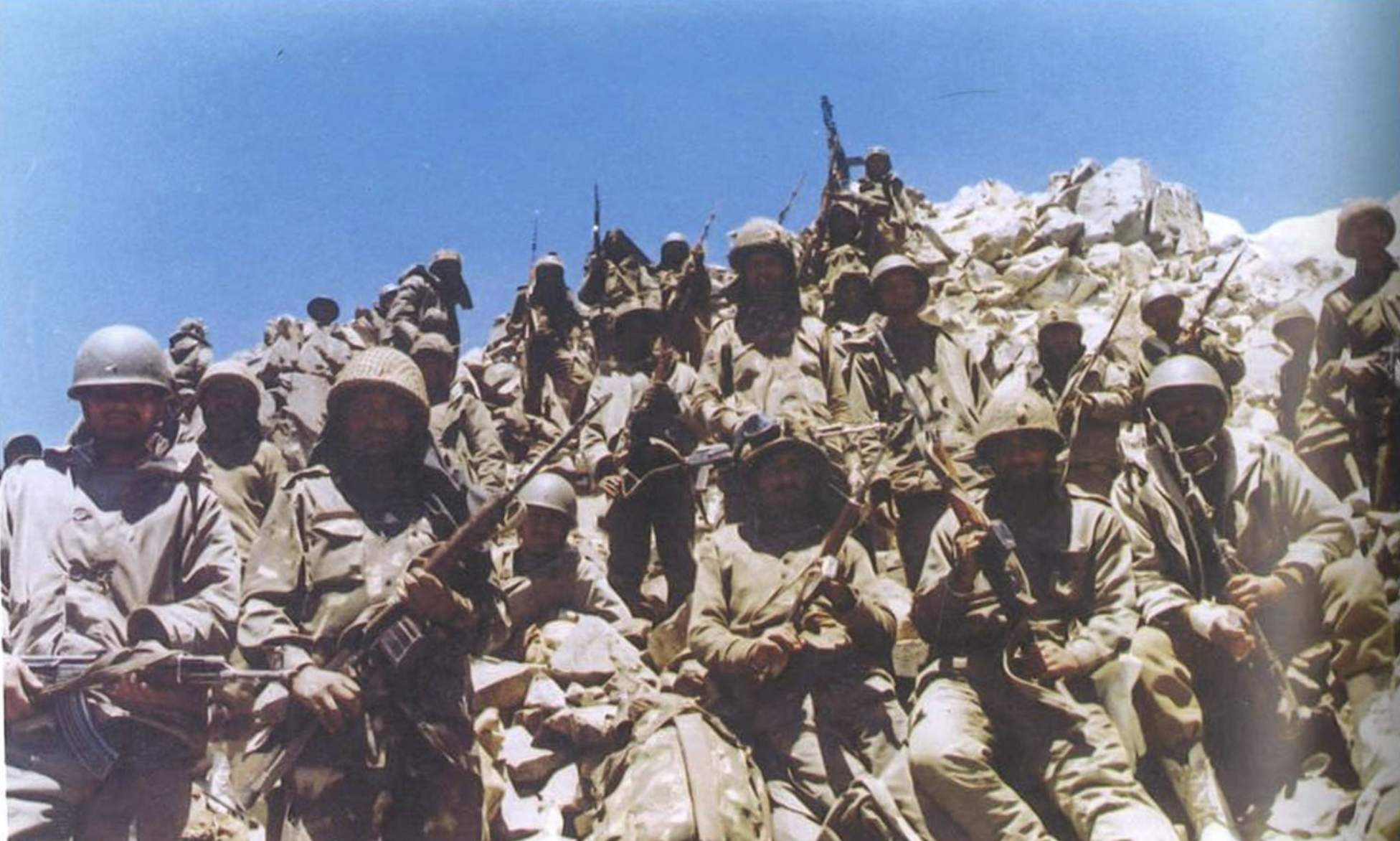
Indian soldiers in Batalika (Kashmir) during the 1999 conflict. Photo: Narendra Modi / Flickr / CC BY-SA 2.0
This time period, the 90s in particular, was immensely violent. It resulted in a number of human rights violations - killings, rapes, enforced disappearances, cordon and search operations, torture, massacres - by the Indian Army, who were granted complete impunity to act as they wished. It is also during this time that most of the Kashmir Valley’s Hindu minority population, the Kashmiri Pandits, under circumstances that have also been deeply contested, migrated out of the valley. The armed rebellion was essentially crushed in the early 2000s, but again starting in 2008 and beyond, there are mass popular agitations against the Indian state. This time too the protests result in killings and massacres and additional human rights violations.
That brings us to 2019, when, during Narendra Modi’s second term as Prime Minister, the semi-autonomy that Kashmir had been granted under Article 370 was abrogated. Right before Article 370 was abrogated, all forms of communications in Kashmir were cut off and additional armed forces were deployed. While Kashmiris were cut off from the rest of the world for months, laws were changed to allow Indians to buy land and settle in Kashmir. India’s settler colonial project was advanced further in Kashmir.
And so there are fears now of actual and drastic demographic change that will further dispossess Kashmiris, Muslims in particular, and serve as a mechanism to completely deny the people of Kashmiri any future possibilities of self determination.
Could you highlight the significant milestones and phases of the Kashmiri Independence Movement and identify the major organizations and figures involved in the movement?
I see Kashmir's movement primarily as a movement for self-determination because in some sense the struggle overall has been a struggle to grant or give people the opportunity to decide their future for themselves. As for liberation, there are actually different visions of what liberation is for Kashmir. In the 1950s, the All Jammu and Kashmir Plebiscite Front and a number of other smaller parties began calling for the UN backed plebiscite to take place in the region. Then once you get to the 1970s and 1980s, several groups emerge that have different visions than the Plebiscite Front. Among these groups, there are some, like the Jamaat-e-Islami Kashmir, that have historically sought Kashmir to merge with Pakistan. There was also a group in the 70s called the Jammu Kashmir Liberation Front (JKLF) that was created outside Indian Occupied Kashmir, on the other side of the border and in the UK, and came to prominence through the decades leading up to the armed rebellion of the 90s. JKLF articulated a vision of an independent nation state for Kashmir, and the group also had an armed wing. The primary pro-Pakistan armed group was the Hizbul Mujahideen.
One of the predicaments that has existed within the broader liberation movement is that liberation groups with contesting ideologies have at times struggled more against each other than they have with the actual colonial power. In the early 1990s, all of the different political formations in Kashmir formed an umbrella organization called the All Parties Hurriyat Conference, although there were several splinters over time. In 2016, three leaders in particular formed the Joint Resistance Leadership. One of the three leaders was Yasin Malik, who was involved with the Jammu Kashmir Liberation Front. Today he is serving a life sentence at the Indian Tihar Jail in Delhi. Another leader of the conference was Syed Ali Shah Geelani, who resolutely called for Kashmir to join Pakistan. He died in 2021, after being under house arrest for years. And then there's Mirwaiz Umar Farooq, a religious leader and the current chairman of the All Parties Hurriyat Conference.

Syed Ali Shah Geelani, centre, flanked by leaders Joint Resistance Leadership Yasin Malik, right, and Mirwaiz Umar Farooq, left, during a 2015 protest in Narbal near Srinagar. Photo: Mukhtar Khan / AP
As with most liberation movements, there's been struggles in terms of how the opposition parties can actually operate on the ground because they have been consistently criminalized by the Indian State. Many of the leaders of these groups have been arrested and imprisoned for several years. Many have been assassinated over the years as well. Aside from Indian State imposed curtailments, there's also contestations in terms of how much they want to negotiate or concede to the Indian State.
How does religious identity influence local politics in diverse Kashmir, and is there a predominant religious unity that takes precedence over national identity? In the struggle for freedom, what role do religious minorities play? We understand that Kashmir has a considerable Sikh and Hindu (pandit) population. How has oppression affected them and how have they responded to it?
I think religious identity plays a significant role in Kashmir's politics and also in how colonial occupation operates overall. Religious identity has been used by the ruling governments, whether the Dogras or the Indian State, to create divisions in Kashmiri society. Ethnic identity lines are also drawn, of course, but I think in Kashmir the divide and rule policy has occurred largely on religious and also regional lines. And part of why that's the case is that the political economy of the state and the denial of rights under the Dogras also operated on religious differences. Similarly, the privileges that were given to certain communities were also religiously determined.
From the side of the oppressed, because it's been the Kashmiri Muslim population in particular that has been marginalized or has been denied their right to self determination, Islam has played an important role in terms of how Kashmiri Muslims have understood their struggle. In the period that my work concentrates on, the 1950s and 60s, the post-47 client regimes in Kashmir knew that Muslims in particular were going to be difficult to integrate into the larger Indian Union. They felt that the Muslim populations could be swayed by Pakistan, which was an Islamic Republic and the other option available to the Kashmiris in the scenario of the plebiscite. To prevent that from happening, the client regimes gave Kashmiri Muslims certain privileges and empowered them as a community. This caused tensions between Kashmiri Muslims and Kashmiri Pandits/Hindus, most of whom were upper caste Brahmins and had historically been in positions of power and privilege. The claims to employment, administrative service, and education that Kashmiri Muslims now made created tensions between Muslims and Pandits because the Pandits felt that their previous privileges were being taken away.
Because of their history in previous administrations, most Pandits have seen their political aspirations differently from Kashmiri Muslims. While most Kashmiri Pandits saw their future within the Indian Republic, most Kashmiri Muslims aligned themselves with the movement for Pakistan or independence. In this sense, the Kashmiri struggle for freedom has largely been a Muslim one, although of course there have been some Pandits and members of other religious communities that have been a part of the struggle as well.
Another thing that the State does and has historically done to maintain rifts between religious communities is that it has used acts of violence against the religious minorities in Kashmir to undermine the broader struggle. One example of this is the Chittisinghpura Massacre of 2000, in which 35 Sikh villagers were murdered. Chattisinghpura, which is a predominantly Sikh village, was attacked by “unknown forces” in 2000 right before the high profile visit of then US President, Bill Clinton. The Indian State blamed “Kashmiri rebels'' for the attacks, but even members of the Sikh community and people living in the area at the time overwhelmingly stated that it was the Indian State forces that committed the massacre in order to undermine the Freedom Movement and present the rebels as terrorists on the global stage. In this way, by casting the interests of minority communities against majority ones, the Indian State has often furthered a sense of insecurity among religious minorities in Kashmir and sowed antagonisms between them and the Muslim majority. They are also able to do this given broader global Islamophobic currents.
Does the Kashmiri language play a significant role as a means of political expression and struggle among the local population?
I think one of the interesting things about the Kashmiri Freedom Movement is that it hasn't necessarily foregrounded the characteristics that often animate national liberation movements, things like language, a flag or even other cultural works. Of course, I think language is important for Kashmiris, but I don’t see Kashmiri serve as a site of political struggle like Bangla did in the case of East Pakistan, for example, which eventually became Bangladesh. One of the things that I noticed in my work is that in the 1950s and 60s, Kashmiri elites and the upper class along with large sections of people from rural areas internalized this idea that Kashmiri was a backwards language and that it didn't really have a modernizing impetus. And because at this time, people in Kashmir as well as the client regimes administrating the region were interested in modernizing, they saw Urdu and English as modern languages that the people needed to learn. Kashmiri was administratively relegated to the cultural sphere. And yes, folk traditions were collected in Kashmiri, history and some literature was written in it, and so on, but the language itself wasn't really seen as a political threat by the Indian state. This is potentially bound to change, though, as Hindu nationalists in India today are seeking to impose Hindi in Kashmir and undermine local languages.

Graffiti on one of the streets of Srinagar. Photo: Jalees Andrabi
In the past decade or so, a greater amount of scholarly focus has been placed on the gendered dynamics of Kashmir’s chronic oppression. How have women and other gender minorities contributed to the freedom struggle? What are the differences in contribution (if any) and how do they inform the larger thrust of the movement against Indian oppression?
Within all of these colonial contexts, historically and even at the present, a very similar template is used whereby the colonizer often portrays itself as the savior of the women and gender minorities against the patriarchy of the colonized men. But Kashmiri women and gender minorities have consistently challenged this savior mentality by pointing to India's occupation as being the primary vector of oppression, to which then, other oppressions are linked. Kashmiri women have played a vital role in the struggle historically by constantly participating in protests, protecting rebel fighters, and creating organizations, such as the Association of Parents of Disappeared Persons, that have documented and protested human rights abuses exacted by the Indian State. They've also served as sources of support for families that have been impacted by state atrocities. Women also faced the brunt of the state's violence as the Indian Army has used rape and sexual violence as a weapon of war, not just against Kashmiri women, but also against Kashmiri men.
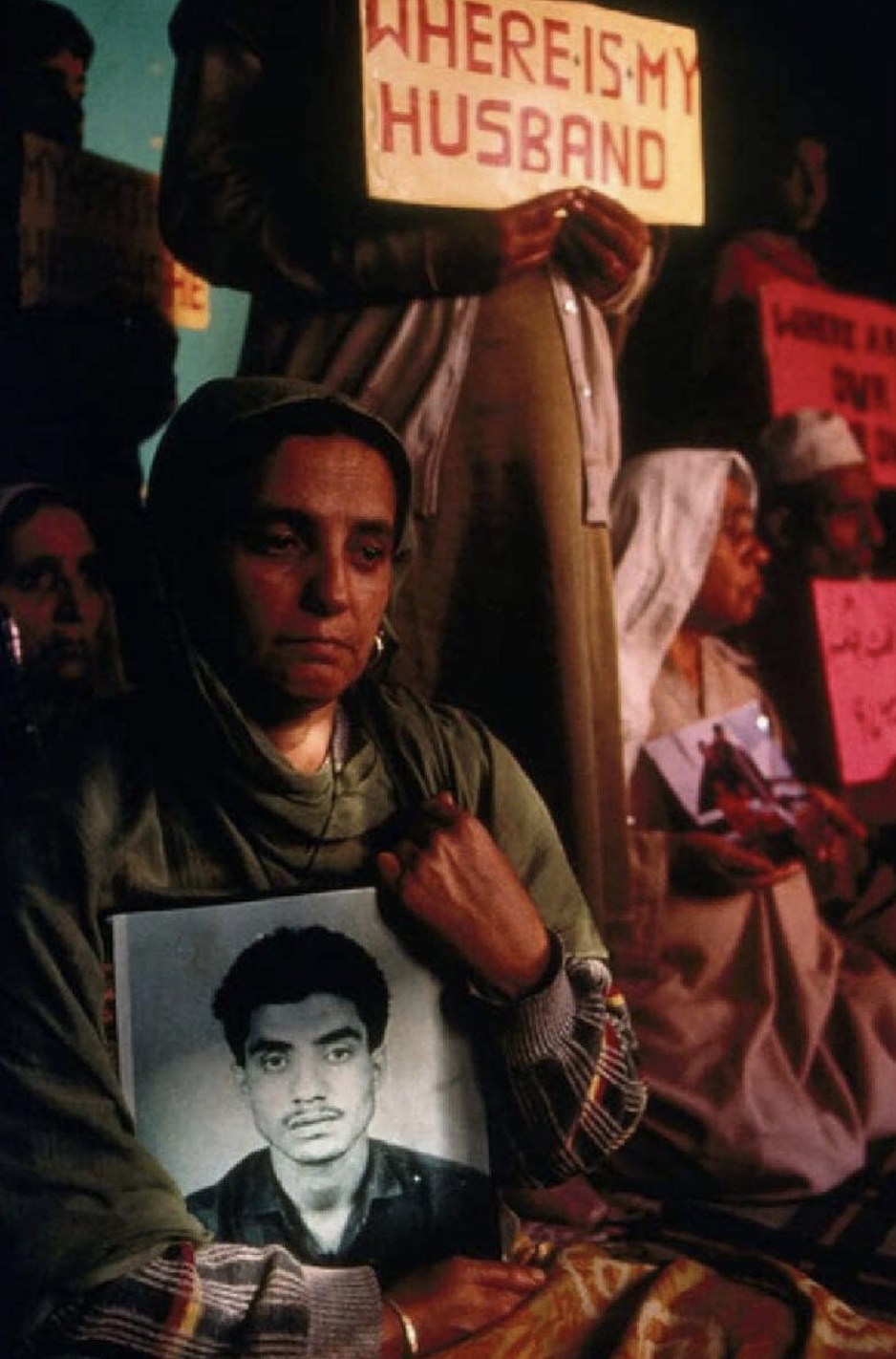
Co-founder of the Association of Parents of Disappeared Persons, Parveena Ahangar, Kashmir, 1999. Photo: Steve McCurry
Does the Indian public recognize and appreciate Kashmir’s distinct cultural identity? If so, how did the perception evolve to the point that now they believe Kashmir is their land to protect and keep?
In the decades after India’s Independence in 1947, there was this push in India for unity in diversity. How I look at this idea is that there was a forcible inclusion of Kashmir into the Indian Republic whereby the cultural identity prescribed to Kashmir was not necessarily seen as a threat, but rather used and incorporated into understandings of a greater idea of India or an Indian civilization. There was a complete denial or rejection of Kashmir's Muslim identities, in favor of a syncretic, Hindu-oriented identity. It's really remarkable to me how much work has gone into creating Kashmir as a space of desire, but also creating the sense of ownership of Kashmir in India. Even when bringing up Kashmir to an average Indian, who likely has incredibly nationalist ideas, the one thing that they'll say is that Kashmir is an integral part of India. Kashmir is this one thing that India cannot let go of! And by that I mean largely the land — of course it doesn't matter what happens to the people, especially the Muslim people. The Kashmiri people are getting in the way of the Indians who want to enjoy and absorb the scenery. There's both this desire for the land, the space of Kashmir, but a complete dehumanization of the people of the region.

